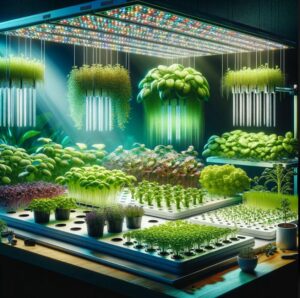Optimizing Growth: Proper Grow Light Distance for Healthy Plants
Optimizing Growth: Proper Grow Light Distance for Healthy Plants
Light plays a pivotal role in plant photosynthesis, the process vital for growth and health in plants. For indoor gardens, where natural sunlight is often limited, grow lights offer a simulated sunlight spectrum that can significantly enhance plant growth. The key to harnessing the full potential of these lights lies in the correct placement distance from the plants, impacting their health, growth, and productivity. Inadequate spacing can result in stunted growth, nutrient issues, or even light burn.

Understanding the Optimal Distance Between LED Grow Lights and Plants
Finding the ideal position for your grow lights involves understanding the type of light, its wattage, the growth stage of your plants, and their specific species requirements. This knowledge helps in creating the perfect environment for your indoor garden or hydroponic system.
Choosing the Right Type of Grow Light for Microgreens and Indoor Gardens
Different grow lights emit varying levels of heat and intensity, which influences how close they should be to your plants:
- LED Grow Lights: Ideal for microgreens and hydroponic systems due to their cool operation, allowing placement of 12 to 24 inches from plants.
- HID Lights: These require a distance of 24 to 36 inches due to their higher heat output.
- Fluorescent Lights: Suitable for lower heat emission, can be positioned 6 to 12 inches above the plants.
Wattage and Light Intensity in Hydroponic and Indoor Gardening
The power of your grow light affects its ideal distance from the plants. High-wattage units produce more heat and light, requiring a greater distance to avoid damage, while lower wattage units can be placed closer. Measuring light intensity can help tailor your setup for optimal growth.
Growth Stage Considerations for Effective Light Placement
Adjusting light distance based on your plants’ growth stage ensures they receive the appropriate light intensity:
- Seedlings/Cuttings: Need less intense light, necessitating a farther placement or dimming capabilities.
- Vegetative Stage: Plants benefit from closer, more intense light to foster foliage growth.
- Flowering Stage: Light intensity may need adjustments to protect flowers and buds from damage.
Species-Specific Light Requirements
Understanding the light needs of different plant species is crucial. Low-light plants require less intensity compared to those that thrive in full sun. Customizing your light setup based on species ensures all plants receive their ideal light conditions.
Monitoring and Adjusting Grow Light Distance
Regularly adjusting your grow lights to maintain the correct distance is vital as plants grow. Adjustable hangers or stands simplify this process, helping prevent issues related to incorrect light spacing.
Signs of Inappropriate Grow Light Placement
Keep an eye out for symptoms indicating your grow light distance might be off:
- Light Burn: Manifests as yellowing or browning leaf tips.
- Stretched Growth: Long gaps between nodes suggest the light is too far away.
- Weak Seedlings: A sign of insufficient light, causing them to grow leggy.
Advanced Techniques: Utilizing Light-Moving Systems
For even growth and optimized light coverage, consider light-moving technology. This system minimizes intensity variations and hotspots, potentially allowing lights to be placed closer to plants for more uniform growth.
Final Thoughts on LED Grow Lights in Hydroponic and Indoor Gardening
Finding the right grow light distance is a delicate balance that, when achieved, can lead to flourishing, productive plants. By understanding your lights’ specifications, closely observing plant responses, and making necessary adjustments, you can create an ideal environment for your indoor garden or hydroponic setup. Remember, what works for one garden may not work for another; personal observation and customization are key to success.
